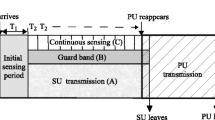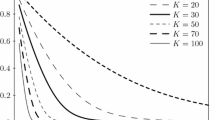Abstract
In cognitive radio networks, spectrum sensing errors are unavoidable, and it is necessary to evaluate the negative effects of spectrum sensing errors on the system performance. In this paper, we consider and analyze the system performance of a cognitive radio network with non-ideal spectrum sensing. Considering the diversity of data transmission in modern communication networks, we also introduce multiple classes of secondary users (SUs) into the system evaluation. By building and analyzing a discrete-time Markov chain model, we obtain formulas for the collision probability, and the interruption rate and the average delay for the SU packets with lower priority. Finally, with the help of numerical results, we show the influence exerted the non-ideal spectrum sensing.
Access this chapter
Tax calculation will be finalised at checkout
Purchases are for personal use only
Similar content being viewed by others
References
Saleem, Y., Rehmani, M.H.: Primary radio user activity models for cognitive radio networks: a survey. J. Netw. Comput. Appl. 43, 1–16 (2014)
Ghasemi, A., Sousa, E.S.: Spectrum sensing in cognitive radio networks: requirements, challenges and design trade-offs. IEEE Commun. Mag. 46, 32–39 (2008)
Tang, S.: A general model of opportunistic spectrum sharing with unreliable sensing. Int. J. Commun Syst 27, 31–44 (2014)
Jin, S., Yue, W., Ge, S.: Equilibrium analysis of an opportunistic spectrum access mechanism with imperfect sensing results. J. Ind. Manag. Optim. 13, 1255–1271 (2017)
Lee, Y., Park, C.G., Sim, D.B.: Cognitive radio spectrum access with prioritized secondary users. Appl. Math. Inf. Sci. 6, 595S–601S (2012)
Zhao, Y., Yue, W.: Cognitive radio networks with multiple secondary users under two kinds of priority schemes: performance comparison and optimization. J. Ind. Manag. Optim. 13, 1449–1466 (2017)
Zakariya, A.Y., Rabia, S.I.: Analysis of an interruption-based priority for multi-class secondary users in cognitive radio networks. In: Proceedings of IEEE International Conference on Communications, pp. 1–6 (2016)
Zhao, Y., Wang, J., Liu, J., Bai, L.: Optimization of access threshold for cognitive radio networks with prioritized secondary users. Mob. Inf. Syst. 2016, 1–8 (2016). Article ID 3297938
Tian, N., Zhang, G.: Vacation Queueing Models: Theory and Applications. Springer, New York (2006). https://doi.org/10.1007/978-0-387-33723-4
Alfa, A.S.: Queueing Theory for Telecommunications: Discrete Time Modelling of a Single Node System. Springer, New York (2010). https://doi.org/10.1007/978-1-4419-7314-6
Acknowledgments
This work was supported in part by the National Natural Science Foundation of China (No. 61701097, No. 61472342), the Natural Science Foundation of Hebei Province (No. F2016501073), the Doctoral Scientific Research Foundation of Liaoning Province (No. 201601016), the Scientific Research Fund of Hebei Education Department (No. QN2016307), China, and was supported in part by MEXT, Japan.
Author information
Authors and Affiliations
Corresponding author
Editor information
Editors and Affiliations
Rights and permissions
Copyright information
© 2018 Springer International Publishing AG, part of Springer Nature
About this paper
Cite this paper
Zhao, Y., Yue, W. (2018). Cognitive Radio Networks with Non-Ideal Spectrum Sensing and Multiple Classes of Secondary Users. In: Takahashi, Y., Phung-Duc, T., Wittevrongel, S., Yue, W. (eds) Queueing Theory and Network Applications. QTNA 2018. Lecture Notes in Computer Science(), vol 10932. Springer, Cham. https://doi.org/10.1007/978-3-319-93736-6_12
Download citation
DOI: https://doi.org/10.1007/978-3-319-93736-6_12
Published:
Publisher Name: Springer, Cham
Print ISBN: 978-3-319-93735-9
Online ISBN: 978-3-319-93736-6
eBook Packages: Computer ScienceComputer Science (R0)




